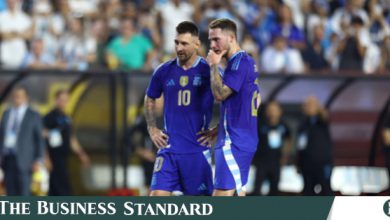The Tactical Conundrum of Vinícius Júnior and Kylian Mbappé: Can They Coexist at Real Madrid?

Real Madrid’s recent triumph over Atalanta to claim the UEFA Super Cup for a record sixth time has further solidified their status as one of the most formidable football clubs in the world. The match also marked the much-anticipated debut of Kylian Mbappé, who dazzled fans with a goal, while Vinícius Júnior once again showcased his brilliance by effortlessly slicing through the Atalanta defense. Despite the celebration surrounding this victory, a formidable question lingers in the minds of Madridistas: how will Vinícius and Mbappé operate together on the pitch?
Both Vinícius Júnior and Kylian Mbappé are naturally left-wingers, a characteristic that, while highlighting their individual brilliance, could present significant challenges when paired together. The potential issues that could arise from their partnership stem from several factors, including positional conflict, reduced individual output, tactical imbalance, defensive vulnerabilities, and a lack of complementary play.
Positional Conflict: A Battle for Space
Vinícius Júnior and Kylian Mbappé have each built their careers on exploiting the left wing, a position that allows them to fully utilize their pace, dribbling, and ability to cut inside to create scoring opportunities. Vinícius, for instance, has thrived on the left, where he contributed 23 goals and 21 assists during the 2022-2023 season. His success comes from taking on defenders in one-on-one situations, a skill that is maximized when he operates from the left flank.
Similarly, Mbappé has dominated from the left wing, where his blistering speed and clinical finishing have made him one of the most feared forwards in world football. In the 2022-2023 season, Mbappé scored 41 goals and provided 10 assists, with the majority of his contributions coming from the left side. His ability to cut inside from the wing and finish with his stronger right foot is a hallmark of his game.
However, the problem arises when two players who thrive in the same space are forced to share it. If Vinícius and Mbappé are to operate together, they may find themselves occupying each other’s space, leading to positional congestion. This overlap could diminish their effectiveness, as both players might struggle to find the room they need to exploit defenses effectively. Instead of complementing each other, they could unintentionally hinder each other’s natural game, leading to fewer clear-cut chances and a less potent attack.
Reduced Individual Output: A Decline in Efficiency
The positional conflict between Vinícius and Mbappé could also result in a decline in their individual output. When two players with similar attacking tendencies are forced to operate in the same zone, their overall productivity might decrease. For instance, if Mbappé is pushed into a central or right-wing role to accommodate Vinícius, his goal-scoring rate might drop. Historically, Mbappé’s goals per 90 minutes have been higher on the left, ranging from 0.8 to 1.0, compared to around 0.6 to 0.7 when playing centrally or on the right.
Vinícius could face a similar issue. If he is forced to adapt to a different role, such as playing more centrally or switching flanks, his dribbling success rate and ability to create high-quality chances might decline. In the 2022-2023 season, Vinícius had a dribble success rate of around 50-55%, with most of these successful dribbles coming from the left side. A change in position could reduce his impact, potentially leading to a less effective contribution to the team’s overall attacking output.
Tactical Imbalance and Predictability: A Lopsided Attack
Another significant concern is the potential for tactical imbalance and predictability in Real Madrid’s attack. With both Vinícius and Mbappé favoring the left side, the team’s offensive play could become lopsided, focusing too much on one flank and making it easier for opponents to defend against. Teams could simply overload their right side defensively, effectively stifling Madrid’s attack by cutting off the supply lines to Vinícius and Mbappé.
Statistical evidence supports this concern. Both players’ heat maps from the 2022-2023 season show a heavy concentration of activity on the left side, with limited involvement on the right. If both are on the field together, the lack of balance might lead to fewer opportunities created from other areas, reducing the overall effectiveness of the team’s attack. In a sport where unpredictability is often key to breaking down defenses, a one-dimensional approach could prove detrimental.
Defensive Vulnerabilities: An Overexposed Left Flank
Beyond the attacking implications, the partnership between Vinícius and Mbappé could also create defensive vulnerabilities for Real Madrid. Both players are naturally attack-minded, and while they are capable of tracking back, their primary focus is on contributing to the offensive phase of play. If both players concentrate on attacking from the left, it could leave the left-back exposed, forcing the team to compensate by pulling midfielders out of position. This could weaken the team’s defensive structure, making them more susceptible to counter-attacks.
In the 2022-2023 season, both Vinícius and Mbappé averaged fewer than two tackles and interceptions per game, indicating that their primary focus is on attacking rather than defending. This could be problematic if the left side becomes overloaded with two attack-first players, leaving gaps for opponents to exploit on the counter. In high-stakes matches, where defensive discipline is crucial, such vulnerabilities could prove costly.
Lack of Complementary Play: A Clash of Styles
The final challenge in pairing Vinícius and Mbappé lies in their similar playing styles, which might prevent them from complementing each other effectively. Both players prefer to run at defenders, cut inside, and take shots or provide key passes. However, if they are both trying to do this from the same side, it could lead to a lack of complementary play. Instead of one player creating space for the other, they might unintentionally hinder each other’s effectiveness.
This clash of styles could also impact key metrics such as key passes and assists. While both players are capable of creating chances, their key passes per 90 minutes might decline if they are forced to adjust their natural game. For instance, Mbappé averaged around 1.5 to 2 key passes per 90 minutes in the 2022-2023 season, but this could drop if he is not in his preferred position. The same could be true for Vinícius, whose ability to create chances might suffer if he is not operating in his favored role.
A Partnership of Potential Pitfalls
While the prospect of Vinícius Júnior and Kylian Mbappé playing together at Real Madrid is undeniably exciting, their similar playing styles and preference for the left wing could lead to significant tactical challenges. Positional overlap, reduced individual output, tactical imbalance, defensive vulnerabilities, and a lack of complementary play are all potential issues that could arise if the two players are forced to share the same space on the pitch.
For Real Madrid, the key to unlocking the full potential of this partnership will be finding a way to balance their strengths while minimizing these potential pitfalls. Whether through tactical adjustments, positional rotations, or strategic changes in play, the club will need to carefully manage the relationship between these two world-class talents to ensure that their combined presence enhances, rather than hinders, the team’s overall performance.





